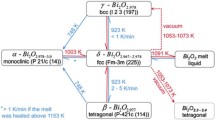Abstract
Nanomaterials are playing an increasingly important role in modern technologies. Interfaces are crucial in nanotechnology. In this study, we have examined the stability of nanoparticles. Major emphasis is on understanding the effect of interfaces on melting. Melting behaviour of nanocrystalline interfaces, created by embedding lead and bismuth nanoparticles in quasicrystalline matrices, was studied. Sharply faceted and coherent interfaces can be related to sharper melting transitions, while irregularly shaped and incoherent interfaces can be directly correlated with lowering of melting temperatures. It is shown here that solid lead forms a high energy interface with phason strain-free quasicrystal (resulting in a lowering of the melting temperature) while bismuth forms a low energy interface with the quasicrystal (resulting in superheating, unusual for bismuth).
Similar content being viewed by others
References
Allen G L, Gile W W, Jesser W A 1980 The melting temperature of microcrystals embedded in a matrix.Acta Metall. 28: 1695
Andersen H H, Johnson E 1995 Structure, morphology and melting hysteresis of ion-implanted nanocrystals.Nucl. Instrum. Methods Phys. Res. B106: 480
Brandes E A (ed.) 1983Smithells metals reference book (London: Butterworths)
Coombes C J 1972 The melting of small particles of lead and indium.J. Phys. F2: 441
Edagawa K, Kajiyama K, Takeuchi S 1998 Thermal expansion and Gruneisen parameters of quasicrystals.Mater. Res. Soc. Symp. Proc.
Faber T E 1972Introduction to the theory of liquid metals (Cambridge: University Press)
Frank F C 1952 Supercooling of liquids.Proc. R. Soc. London A215: 43
Frenken J W M, van der Veen J F 1985 Observation of surface melting.Phys. Rev. Lett. 54: 134
Goswami R, Chattopadhyay K 1995 The superheating and the crystallography of embedded Pb particles in fcc Al, Cu and Ni matrices.Acta Metall. Mater. 43: 2837
Goswami R, Chattopadhyay K 1996a The solidification behaviour of Bi particles embedded in Al matrix.Acta Mater. 44: 2421
Goswami R, Chattopadhyay K 1996b Depression of melting point of multidomained bismuth in aliminum based metallic glass of nanocomposites.Appl. Phys. Lett. 69: 910
Goswami R, Chattopadhyay K 1999 The melting and solidification of nanoscale Bi embedded in a glassy and crystalline matrix.Philos. Mag. Lett. 79: 481
Grabaek L, Bohr J, Johnson E, Johansen A, Sarholt-Kristensen L, Andersen H H 1990 Superheating and supercooling of lead precipitates in aluminum.Phys. Rev. Lett.64: 934
Holzer J C, Kelton K F 1991 Kinetics of the amorphous to icosahedral phase transformation in AlCu-V alloys.Acta Metall. Mater. 39: 1833
Kay G W C, Laby T H 1959Physical and chemistry constants (London: Longmans)
Metals handbook 1990 Properties and selection: Non-ferrous alloys and special purpose materials. 10th edn. (Am. Soc. Met.) vol. 2, p. 1130
Miedema A R 1978 Surface energies of solid metals.Z. Metallkd. 69: 287
Miedema A R 1978-79 The atom as a metallurgical building block.Philos. Tech. Rev. 38: 257
Miedema A R, Boom R 1978 Surface tension and electron density of pure liquid metals.Z. Metallkd. 69: 183
Miedema A R, Den Broeder F J A 1979 On the interfacial energy in solid-liquid and solid-solid metal combinations.Z. Metallkd, 70: 14
Moore K I, Zhang D L, Cantor B 1990 Solidification of Pb particles embedded in Al.Acta Mater. 38: 1327
Pluis B, van der Gon A W D, Frenken J W M, van der Veen J F 1987 Crystal face dependence of surface melting.Phys. Rev. Lett. 59: 2678
Roth M, Weatherly G C, Miller W A 1975 On superheating and supercooling of lead and bismuth inclusions in aluminum.Can. Metal. Q. 14: 287
Saka H, Nishikawa Y, Imura T 1988 Melting temperature of In particles embedded in an Al matrix.Philos. Mag. A57: 895
Sasaki K, Saka H 1991In situ high-resolution electron microscopy observation of the melting process of In particles embedded in an Al matrix.Philos. Mag. A63: 1207
Sheng H W, Lu K, Ma E 1998 Melting and freezing behaviour of embedded nanoparticles in ball-milled Al-10wt% M (M = In, Sn, Bi, Cd, Pb) mixtures.Acta Mater. 46: 5195
Singh A, Tsai A P 1998a Heterogeneous nucleation of lead on quasicrystals.Philos. Mag. Lett. 77: 89
Singh A, Tsai A P 1998b Crystallography and solidification behaviour of nanometric Pb particles embedded in icosahedral and decagonal quasicrystalline matrix.Acta Mater. 46: 4641
Singh A, Tsai A P 1999a Stablility on interface between lead particles and quasicrystals and its effect on the melting temperature of the lead particles.Philos. Mag. Lett. 79: 561
Singh A, Tsai A P 1999b Melting temperature of lead nanoparticles embedded in Al-Cu-V amorphous and quasicrystalline matrices.Proc. Int. Conf. Solid-Solid Phase Trans. ’99 (JIMIC-3) (eds) Koiwa M, Otsuka K, Miyazaki T (The Japan Institute of Metals) p. 1353
Singh A, Tsai A P 2000 Melting and solidification behaviour of lead nanoparticles emebdded in amorphous and quasicrystalline matrices of Al-Cu-V.Jap. J. Appl. Phys. 39: 4082
Singh A, Tsai A P 2001 Melting behaviour of bismuth nanoparticles embedded in Al-Cu-Fe quasicrystalline matrix.Scr. Mater. 44: 2005
Southin R T, Chadwick G A 1978 Heterogenous nucleation in solidifying metals.Acta Metall. 26: 223
Takagi M J 1954 Electron diffraction study of liquid-solid transition of thin metal films.Phys. Soc. Jap. 9: 359
Tanaka K, Mitarai Y, Koiwa M 1996 Elastic constants of Al-based icosahedral quasicrystals.Philos. Mag. A73: 1715
Thoft N B, Bohr J, Buras B, Johnson E, Johansen E, Andersen H H, Sarholt-Kristensen L 1995 Melting and solidification of bismuth inclusions in aluminium.J. Phys. D28: 539
Treilleux M, Fuchs G, Montandon C, Santos Aires F, Melinon P, Cabaud B, Hoareau A 1993 Atomic rearrangement of supported Bi particles observed by high-resolution electron microscopy.Philos. Mag. A67: 1071
Turnbull D 1950 Formation of crystal nuclii in liquid metals.J. Appl. Phys. 21: 1022
Zhong J, Zhang L H, Jin Z H, Sui M L, Lu K 2001 Superheating of Ag nanoparticles embedded in Ni matrix.Acta Mater. 49: 2897
Author information
Authors and Affiliations
Rights and permissions
About this article
Cite this article
Singh, A., Tsai, A.P. Melting behaviour of lead and bismuth nano-particles in quasicrystalline matrix — The role of interfaces. Sadhana 28, 63–80 (2003). https://doi.org/10.1007/BF02717126
Issue Date:
DOI: https://doi.org/10.1007/BF02717126




